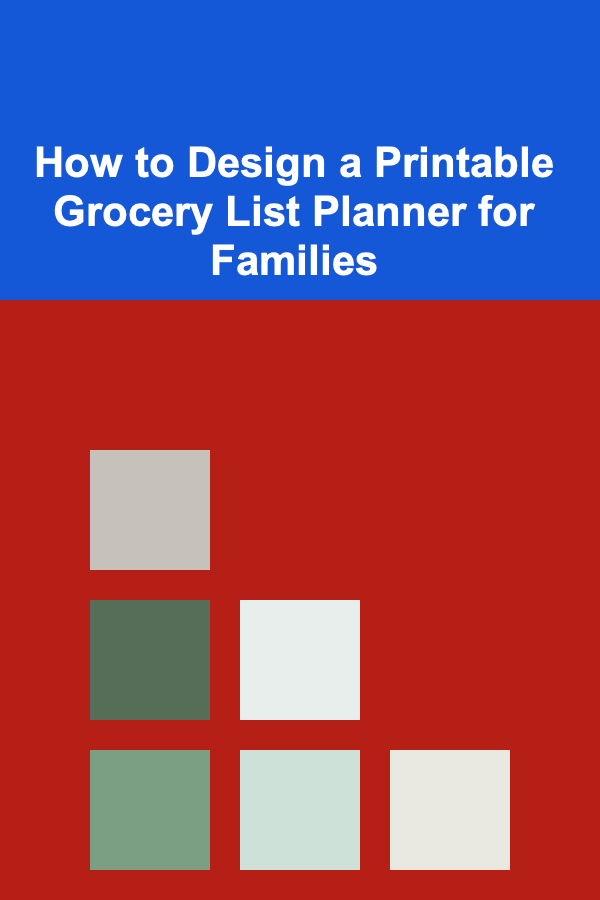
How to Design a Printable Grocery List Planner for Families
ebook include PDF & Audio bundle (Micro Guide)
$12.99$10.99
Limited Time Offer! Order within the next:

Designing a grocery list planner specifically tailored for families is a valuable tool for ensuring that meal planning, shopping, and budget management go smoothly. An organized grocery list not only saves time at the store but also reduces food waste, cuts down on impulse buys, and streamlines family meal preparation. Whether you're a busy parent, a caregiver, or someone simply trying to make grocery shopping a more efficient task, creating a printable grocery list planner can make the process much easier and more effective.
In this article, we'll explore the essential components of a grocery list planner, how to design it with families in mind, and how to make it functional, visually appealing, and easy to use. From understanding family dynamics and shopping habits to the actual design process, we will cover all aspects that will help you create a tool that meets the unique needs of a family-oriented shopping experience.
The Importance of a Family-Oriented Grocery List
Families often face unique challenges when it comes to grocery shopping. With multiple people involved, everyone has different preferences, dietary needs, and schedules to consider. Here are a few reasons why a well-designed grocery list planner is essential:
- Organizational Benefits: A clear, well-structured list ensures that nothing is forgotten and that shopping is efficient. It helps prevent the frustration of returning to the store mid-week for forgotten items.
- Budgeting: A good planner helps families stick to a grocery budget by allowing them to plan meals in advance and avoid buying unnecessary items.
- Meal Planning: Families can plan meals for the entire week, taking into account everyone's schedules and dietary preferences, which minimizes the need for last-minute takeout or convenience meals.
- Reducing Food Waste: Proper meal planning helps families use up what's in the fridge and pantry, reducing the likelihood of expired food being thrown out.
- Health and Nutrition: Planning meals with a grocery list can make it easier to include balanced meals, ensuring everyone gets the nutrition they need.
By addressing these challenges and incorporating these benefits, a printable grocery list planner can be a game-changer for busy families.
Key Features of a Family-Oriented Grocery List Planner
When designing a grocery list planner for families, it's essential to keep in mind both functionality and ease of use. Here are the key elements you should include:
1. Meal Planning Section
Meal planning is the heart of a grocery list, and a dedicated section for it helps families prepare for the week ahead. In this section, families can plan breakfast, lunch, dinner, and snacks for each day of the week.
- Daily Meal Boxes: Provide boxes or checklists for each day of the week so that each family member's meal preferences are accounted for.
- Categorized Meals: You can break the meals down into categories like "breakfast," "lunch," and "dinner" to make it easier for families to assign meals accordingly.
- Dietary Preferences: Include space to note special dietary requirements for individual family members, such as vegetarian, gluten-free, or low-carb.
2. Grocery Categories
To ensure the grocery list is easy to follow and organized, categorize items based on common grocery store sections. This will save time and reduce the need to go back and forth through the store.
- Fruits and Vegetables: A space for fresh produce.
- Dairy and Eggs: For milk, cheese, butter, and eggs.
- Meat and Protein: For meat, poultry, fish, and plant-based protein options.
- Pantry Staples: For grains, canned goods, sauces, spices, and dry foods.
- Frozen Foods: A section for frozen vegetables, prepared meals, and other frozen items.
- Snacks and Beverages: Include chips, cookies, soft drinks, and juice.
- Personal Care and Household Items: Space for non-food items like toiletries, cleaning supplies, and paper products.
By creating separate categories, the grocery list is organized in a way that mirrors the layout of most grocery stores. This prevents the need for double-checking the list or backtracking.
3. Family Contributions Section
Involve each family member in the shopping process by allocating them a section of the grocery list. This could be done based on their preferences or the meals they are in charge of preparing.
- Assign Tasks: For example, one child might be responsible for snacks, while the other is in charge of picking out fruits and vegetables.
- Collaborative Shopping: Encourage the family to add their own favorite items or things they'd like to try during the week. This can make the shopping experience more engaging.
4. Budget Tracker
Grocery shopping can quickly get out of hand when the total cost isn't tracked. Include a section to estimate and track the total cost of the groceries on your list. This is especially useful for families who want to stick to a tight grocery budget.
- Budget Column: A column for writing down estimated prices of each item.
- Total Cost: A section at the bottom where you can sum up the total cost of everything on your list.
- Savings/Discount Section: Include a section for coupon codes, store promotions, or sale prices. Tracking discounts can help you stay within budget while saving money.
5. Inventory Check
A key aspect of grocery shopping is knowing what you already have at home. A pantry or inventory check section allows you to take stock of items that are running low or those that are still stocked.
- Inventory List: Create a section for things you already have in the pantry, fridge, or freezer. This prevents duplicate purchases and helps in meal planning.
- Expiry Dates: If relevant, include a small area where you can write down the expiry dates of items, helping to keep track of items that should be used up first.
6. Weekly Checklist and Notes
Sometimes, families need a space to jot down additional reminders, notes, or important tasks related to grocery shopping or meal preparation.
- Weekly Checklist: This can include things like "Pick up bread," "Check the fridge for leftovers," or "Order groceries online."
- Notes Section: A small section for any special notes, such as "Bring reusable bags" or "Don't forget to buy extra snacks for the school lunch."
7. Printable and Customizable Design
Families' needs vary, so flexibility in design is essential. Providing a customizable, printable version of the planner ensures that each family can tailor it to their specific needs.
- Customizable Templates: Offer various design templates (e.g., minimalistic, colorful, or themed) that can cater to different tastes.
- Editable Sections: Provide editable PDF versions, or allow for additional spaces to be added if families want more room for notes or tasks.
8. Motivational and Fun Design
A grocery list planner should be more than just functional. To make the process more enjoyable for families, use engaging designs that incorporate fun elements like family photos, drawings, or quirky quotes. This can make grocery planning feel less like a chore and more like a collaborative activity.
- Family Photos: Include a space for family photos or artwork that can be customized each week.
- Inspirational Quotes: Add fun and motivational quotes to brighten up the process, especially for younger family members.
Tools and Materials for Designing the Planner
Now that you know the key features that should be included in your grocery list planner, here are some tools and materials you'll need to design it:
1. Design Software
To create a printable, digital planner, you will need graphic design software. Some options include:
- Canva: A user-friendly platform with various templates and design elements.
- Adobe Illustrator: For more advanced designs, if you want full creative control.
- Microsoft Word or Google Docs: These programs are simple and practical if you prefer working with text-heavy planners.
2. Printable Templates
If you're not designing your planner from scratch, consider downloading free or paid templates. Many websites offer customizable grocery list templates that you can print and adapt.
- Etsy: A marketplace for printable planners and templates, where you can find family-oriented grocery list planners.
- Pinterest: A source of inspiration for various grocery list layouts, which can be tailored for family use.
3. Paper and Printing Tools
Once your design is ready, you'll need quality paper and a good printer to bring it to life.
- Paper: Choose high-quality printer paper, preferably heavier weight (around 24 lb or more) for durability.
- Printer: A color printer is ideal, especially if you've included vibrant colors or images in the design.
Conclusion
Designing a printable grocery list planner for families can transform the often chaotic task of shopping into a streamlined, efficient, and enjoyable process. By addressing key components such as meal planning, budget tracking, inventory checks, and family contributions, the planner can meet the unique needs of every household. A well-designed planner not only saves time but also reduces stress, encourages healthier eating habits, and helps stay within budget. With the right tools and a little creativity, you can create a grocery list planner that becomes an indispensable part of your family's weekly routine, simplifying meal prep, reducing food waste, and making shopping a more organized, family-friendly task.
Reading More From Our Other Websites
- [Personal Care Tips 101] How to Train for a Marathon as a Beginner
- [Skydiving Tip 101] Top & Safety Tips Every Tandem Skydiver Should Know
- [Star Gazing Tip 101] Night Sky Adventures: Simple Star‑Gazing Projects for Kids
- [Home Renovating 101] How to Renovate Your Home with DIY Projects
- [Personal Care Tips 101] How to Choose Body Spray for a Relaxing Evening or Night Out
- [Star Gazing Tip 101] Beyond the Stars: The Science of How Constellations Are Formed and Categorized
- [Organization Tip 101] How to Keep Your Outdoor Furniture Organized and Protected
- [Personal Finance Management 101] How to Build an Emergency Fund Without Feeling Overwhelmed
- [Personal Care Tips 101] How to Choose the Best Razor for Sensitive Skin
- [Organization Tip 101] How to Create a Backup Plan for Emergency Pet Supplies

How to Plan a Family Science Experiment Day
Read More
How to Plan a Home Party with a Limited Space
Read More
How to Sell Used Camera Lenses on Facebook Marketplace: An Actionable Guide
Read More
How to Find Short Stories for Language Learners
Read More
How To Build a Strong Esports Team
Read More
Designing Functional Prototypes for Startups: A Deep Dive
Read MoreOther Products

How to Plan a Family Science Experiment Day
Read More
How to Plan a Home Party with a Limited Space
Read More
How to Sell Used Camera Lenses on Facebook Marketplace: An Actionable Guide
Read More
How to Find Short Stories for Language Learners
Read More
How To Build a Strong Esports Team
Read More